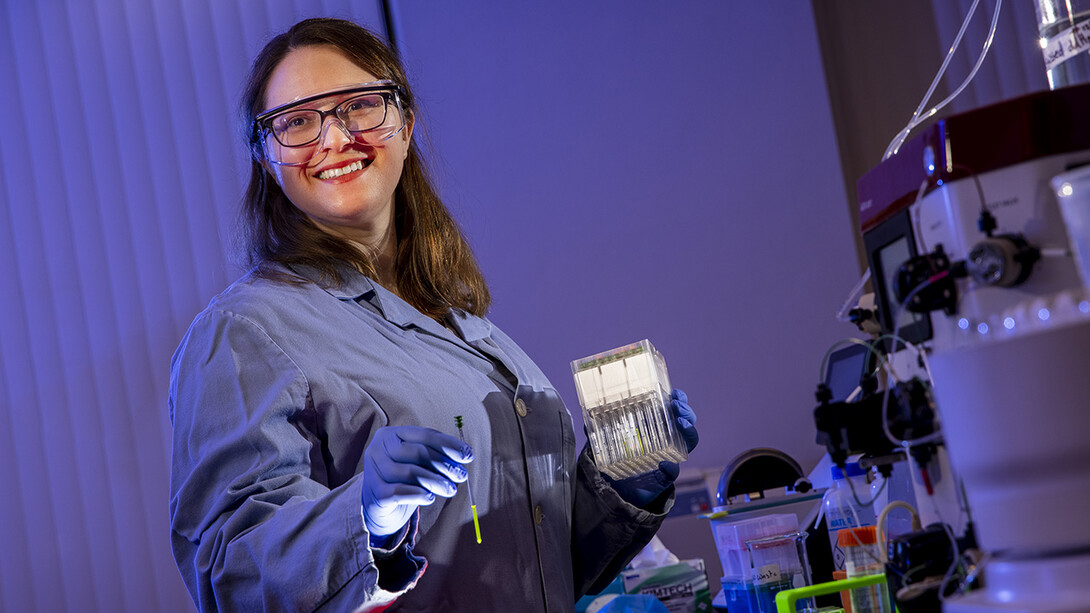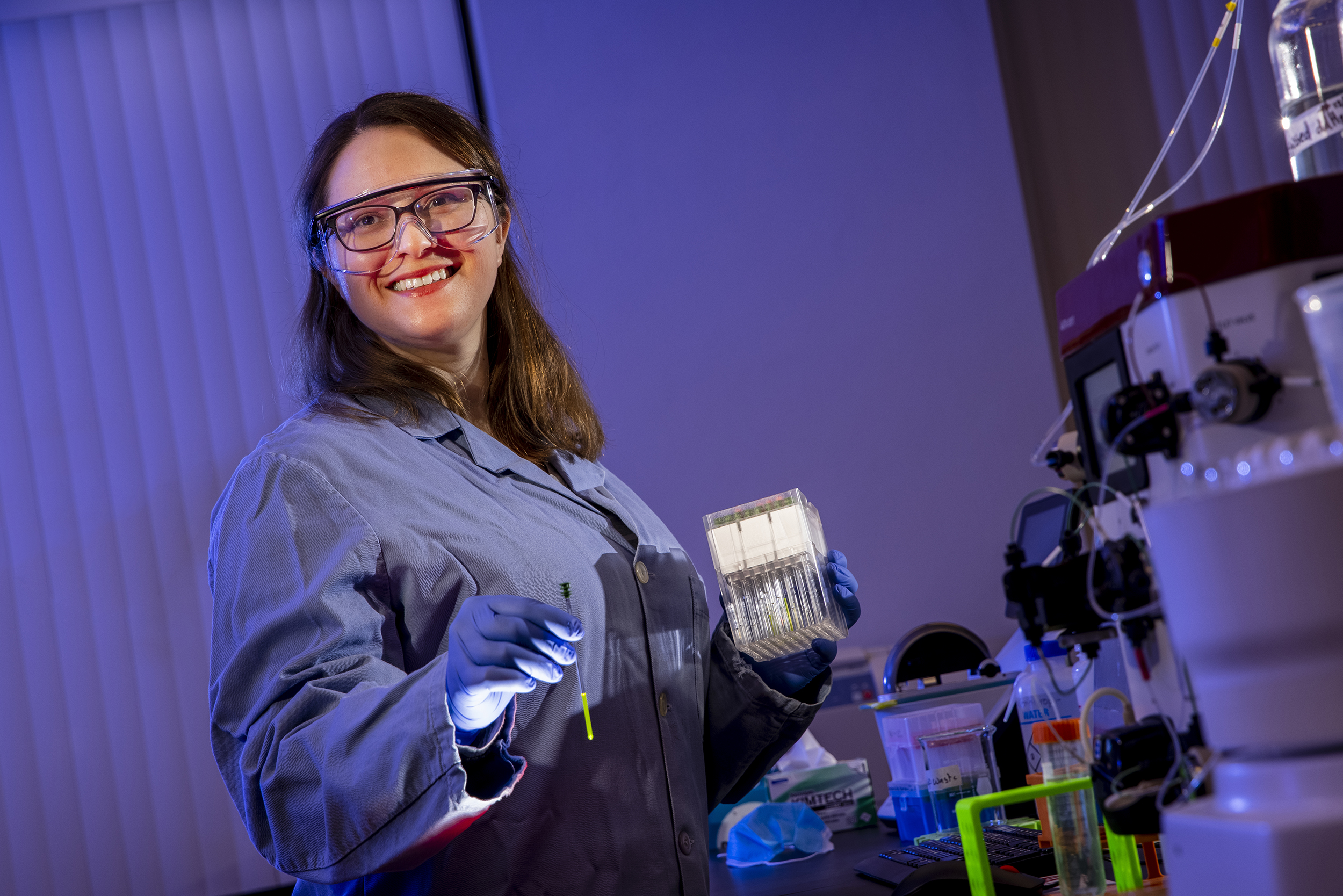
In the conventional view, RNA is a conduit that carries genetic codes from DNA to the protein-building machinery of cells — a passive messenger with no independent role. But over time, scientists have increasingly recognized RNA as an active, distinct player in cellular function, genetic expression and biology. Not only did RNA play a starring role in COVID-19 vaccine development, researchers are also using it to develop treatments for cancer, macular degeneration and lung and liver disease, among other ailments.
Despite the progress, there is still more to learn about RNA before scientists can unlock its full potential, said University of Nebraska–Lincoln chemist Catherine Eichhorn. Much is unknown about how RNA folds into a 3D shape and structure, and how it interacts with other molecules, proteins and co-factors to control cellular function.
With a five-year, $1 million grant from the National Science Foundation’s Faculty Early Career Development Program, Eichhorn will develop a clearer picture of the structure-function relationship in RNA and ribonucleoproteins, or RNPs, which are RNA-protein complexes. She’s focusing her work on 7SK RNP, a key player in regulating gene expression. Using powerful imaging methods, she’ll develop high-resolution images of 7SK’s structures and folding dynamics, aiming to shed light on how RNA and RNPs drive activity in cells.
She’ll also collaborate with Husker students to explore 7SK through an innovative imaging technique that links a fluorescent molecule into 7SK RNA, causing it to “light up” for purposes of real-time, live cell imaging.
“Often, students come to my lab thinking that RNA is just an intermediate between DNA and protein,” said Eichhorn, assistant professor of chemistry. “RNA function is actually widespread across all life forms and is involved in cellular interactions, but we don’t understand at the molecular and atomic level what guides those interactions. This work will advance a better understanding of the biophysical basis of those interactions in cells.”
Her methods and discoveries about 7SK could pave the way for a deeper understanding of the structures and dynamics of RNA and RNPs more generally, potentially laying the foundation for a new generation of RNA-based medical treatments for maladies that include cancer, pain, high cholesterol and genetic disorders, among others.
Eichhorn is focused on 7SK RNP because it regulates the activity of a multiprotein complex known as P-TEFb, which stands for positive transcription elongation factor b. P-TEFb is vital to transcription — the process of copying a gene’s DNA into messenger RNA, which are then used as templates to make the proteins that drive cellular function and activate other genes. Because improper regulation of P-TEFb can give rise to diseases such as heart disease and cancer, scientists have identified it as a promising therapeutic target.
Eichhorn described 7SK RNP as a “temporary holding station” for P-TEFb. It binds P-TEFb, sequestering it in an inactive state until other proteins come along and also bind to 7SK, which triggers the release of P-TEFb. That, in turn, kicks off a crucial phase of transcription known as elongation.
7SK’s role in temporarily binding P-TEFb makes it a potential conduit for controlling gene expression.
“A long-term application would be to harness 7SK’s role in releasing P-TEFb,” Eichhorn said. “P-TEFb could be released to turn on gene expression when we want.”
But before that’s possible, researchers need a deeper understanding of how 7SK RNA folds into a 3D structure and interacts with other molecules. Eichhorn said 7SK is a challenging system to study because it’s heterogeneous and dynamic, which helps explain why few structural biologists have studied it in-depth since its discovery more than 40 years ago. She’ll use traditional biophysical chemistry techniques such as X-ray crystallography, nuclear magnetic resonance spectroscopy and cellular approaches to reveal, for the first time, some of 7SK’s most critical structures and interactions with proteins.
She’ll further investigate 7SK by launching a discovery-based chemical biology laboratory for Husker students, which is a major part of the project’s education component. Eichhorn will guide students in synthesizing a fluorescent RNA aptamer, which is a short strand of RNA capable of binding to a small fluorescent molecule called a fluorogen. When the fluorogen latches onto the aptamer, it becomes fluorescent. The aptamer is engineered into the RNA of interest — in this case, 7SK — enabling researchers to light it up with the fluorogen and track its behavior inside living cells.
In designing the aptamer, Eichhorn said students will have the opportunity to develop and test hypotheses and evaluate outcomes. Through this process, students build their identity as scientists, which can be transformative in propelling students — particularly those from groups underrepresented in STEM — into research careers.
“One focus I’ve really zeroed in on is building a ‘scientist’s identity’ in students,” Eichhorn said. “There is evidence in the literature that one way to overcome disparities in STEM representation is through these types of research experiences, coursework and mentored experiences.”
She’ll recruit students from diverse backgrounds to her lab by partnering with the university’s Upward Bound Math Science program, which helps low-income high school students in Lincoln become first-generation college students at Nebraska.
For the public outreach component of the project, Eichhorn will partner with Upward Bound, the University of Nebraska State Museum and the Nebraska Women in Science Conference to provide the community with hands-on science activities, such as extracting DNA from strawberries, creating DNA origami and making sugar crystals to illustrate crystallography.








